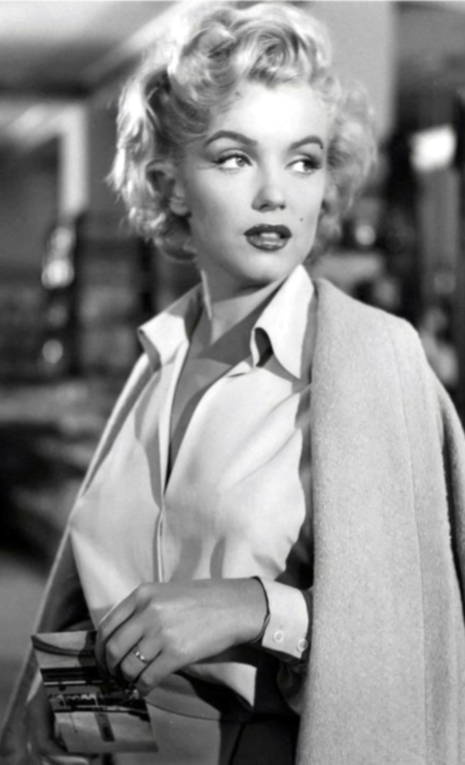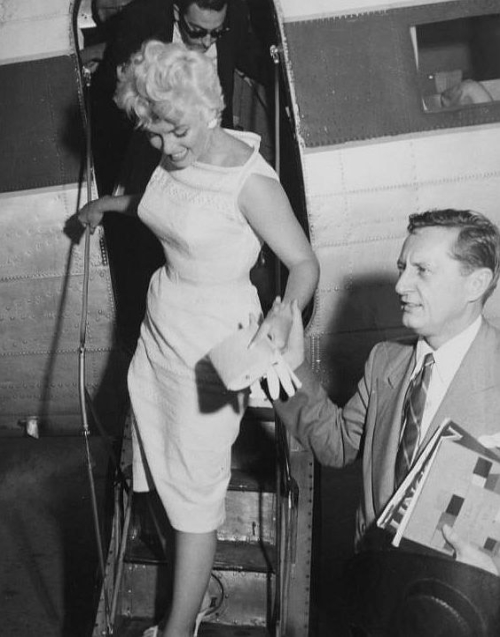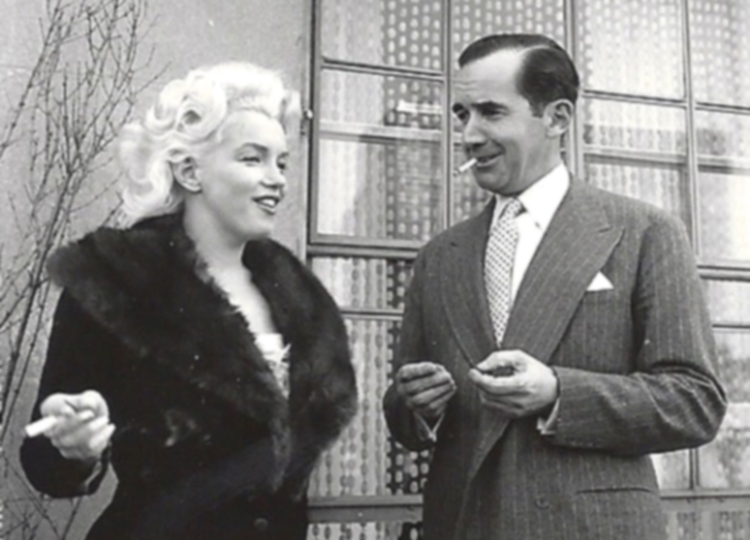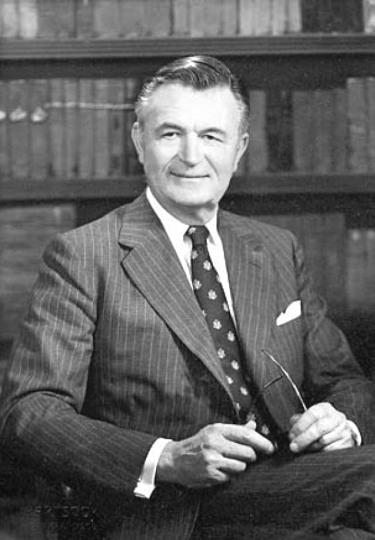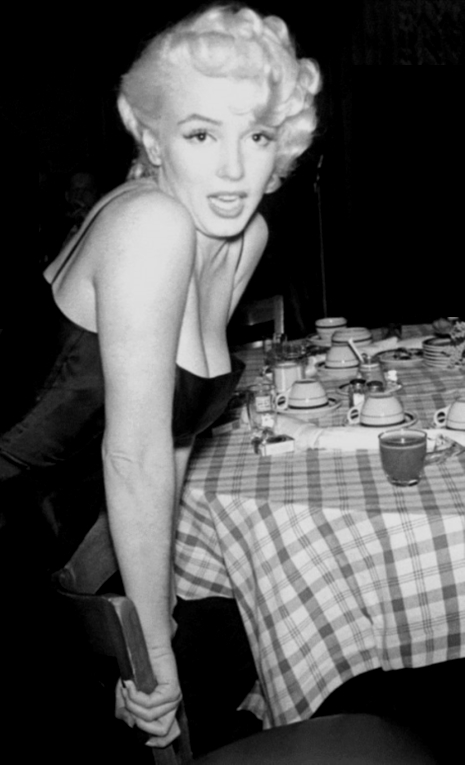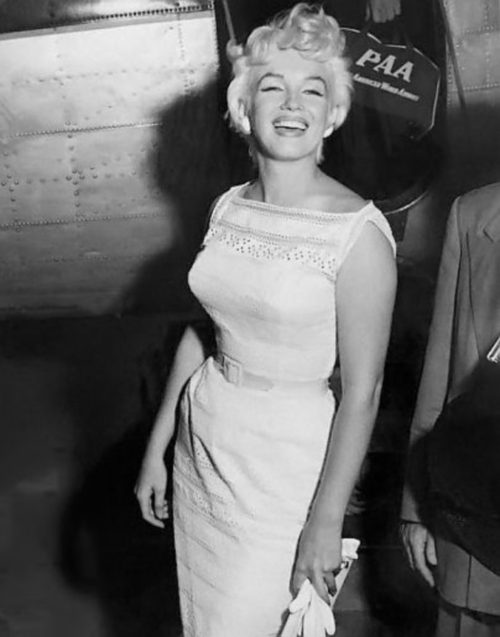Peculiar Photographic Evidence
Within the pages of his book, Mark Shaw incorporated several photographs; and he offered explanatory comments pertaining to each. However, Shaw analyzed the photographs incorrectly; and he commented about what the photographs depicted with an egregious disregard for the facts and the truth. Of course, he trotted out the now famous photograph of Marilyn flanked by John and Robert Kennedy following the 1962 event at Madison Square Garden. Taken at the after party in Arthur and Mathilde Krim’s Manhattan penthouse, Shaw published the cropped version of the photograph, the usual tactic of conspiracist writers. Invariably the photo-graph has also been darkened, suggesting that the famous trio engaged in a secretive and a serious discussion of such import they did not want to be overheard; but Shaw’s analysis of and commentary about the photograph soared to an unprecedented level of misrepresentation and distortion. After implying that Cecil Stoughton, the White House Photographer, actually timed taking the photograph so that the full faces of John and Robert would be hidden from view, Shaw declared: Within moments, JFK, by all credible accounts, asked Marilyn to step into the shadows where RFK stood, and the three of them spoke for more than ten minutes (Shaw 397). Shaw did not divulge exactly who delivered the alleged credible accounts or who conscientiously timed the conversation. At any rate, the actual photograph reveals a much less sinister looking encounter between Marilyn and the middle Kennedy brothers. The left hand photograph in the panel displayed below is the cropped version used by Shaw; but the right hand photograph is the actual snapshot as taken by Stoughton.

Obviously, the movie star and the politicians did not huddle alone in the shadows for ten minutes: they were, in fact, surrounded by many other guests who attended the Krim’s after party. Another photograph taken at the after party clearly indicated the number of people surrounding and touching Marilyn. Steven Smith, married to the Kennedy sister, Jean, and thus a Kennedy brother-in-law, wrapped his arm around Marilyn’s waist, displayed below on the left of the double panel; and many additional photographs indicated the crowded conditions as President Kennedy tried to converse with many of the Krim’s guests, including Jack Benny, displayed below on the right of the double panel. Plus the bespectacled elder man in the background of the left hand photograph was Marilyn’s escort for the evening, her former father-in-law, Isadore Miller.
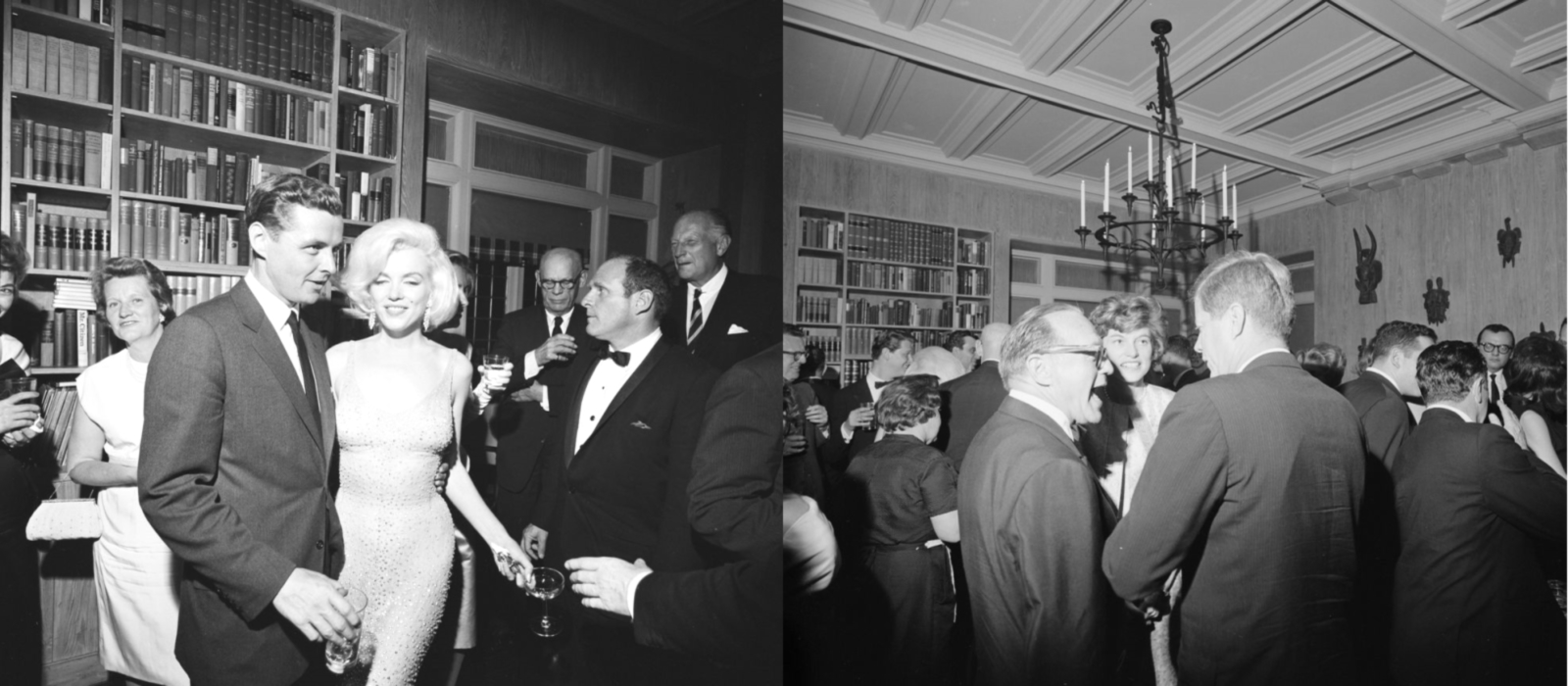
Isadore’s presence did not prevent Shaw from reporting yet another falsity about that historic event. He asserted that the Secret Service escorted President Kennedy and Marilyn from the Krim’s penthouse on to the Carlyle Hotel, where JFK maintained a penthouse. Then Shaw quoted gossip columnist Earl Wilson, who later alleged, following Marilyn’s death: It was the last prolonged encounter between them (Shaw 397). Neither Wilson nor Shaw recounted what actually happened following the Krim’s after party. They simply ignored, disregarded the testimony of the persons actually involved in those events.
During the small morning hours, both Marilyn and Isadore Miller climbed aboard Marilyn’s rented limousine and headed to Brooklyn. She dutifully delivered her former father-in-law to his front door steps. According to Gary Vitacco-Robles, Marilyn implored Isadore to return to the west coast with her when she returned to LA the following day; but he declined and replied: Maybe in November (Vitacco-Robles KEv2:25). After a brief conversation, Isadore exited the limousine. Marilyn blew her former father-in-law a kiss; and then she returned to her 57th Street apartment where she exited the limousine, barefooted, her shoes in hand, and engaged in a brief curbside conversation with one of her ardent fans, James Haspiel. He testified on more than one occasion that Marilyn told him she was exhausted. I can tell you with authority, he later wrote in a publication about his association with her, that I was with Marilyn at her apartment ten minutes to four in the morning. Categorically, Marilyn was not asleep at the Carlyle Hotel, and I didn’t notice the President anywhere nearby us (Vitacco-Robles KEv2:25).
After leaving her fan standing on the sidewalk, she proceeded upstairs to her apartment where Ralph Roberts met her. Ralph testified repeatedly that he massaged Marilyn during that early morning, until she fell asleep. Even so, Shaw asserted that Marilyn and the president had a brief sexual encounter after the Madison Square Garden celebration; but that simply was not the case. Even J. Randy Taraborrelli admitted that his years of research and investigation clearly indicated that such an encounter did not occur. But, once again, the facts do not matter in the world of Marilyn apocrypha, and Mark Shaw was just getting started.
The exact location of Robert Kennedy during the 1962 weekend of Marilyn’s death, specifically on Saturday, August the 4th, has been debated for decades. Where was the evil attorney general? Was he, along with his wife Ethel and four of his then seven offspring, in Gilroy, California, southeast of San Francisco, visiting John and Nancy Bates, their family and ranch? Or, was he in Brentwood visiting and murdering his rejected and distraught lover? Just where the hell was he? The answer: Robert Kennedy and a portion of his family were in Gilroy, California; and according to John Bates, Sr., his wife, Nancy, their eldest son, John Bates, Jr., and the ranch foreman, Roland Snyder, Robert Kennedy did not leave the ranch during Friday or Saturday.
Regarding the attorney general’s location that weekend in August of 1962, Shaw equivocated. He wrote:
[…] there have been suspicions that the last person to see or hear from Marilyn may have been Robert Kennedy, and whomever may have joined him at her new home. While the accounts differ as to the exact time and duration of the potential visit, if true, RFK could have had a confrontational conversation with Marilyn regarding her going to the media and telling secrets threatening him and his family (477: emphasis mine).
It is apparent that Shaw could not simply out-of-hand dismiss the Bates family’s testimony regarding that weekend; and even though he appeared to accept that Robert Kennedy visited Brentwood that Saturday, despite differing accounts regarding that visit, he also equivocated and employed phrases like may have been and may have joined, if true and could have had. Desiring to have his cake while also eating it, Shaw devised and employed another truly bizarre tactic. Bear with me as it unfolds.
The Wrong Car in the Wrong Place
Early on Sunday morning, August the 5th, after the group attended church in Gilroy, John Bates, Sr. drove his visitors back to San Francisco and delivered them to the home of Paul Fay, Sr. The Kennedy family visited the Fays until the attorney general delivered his speech to the American Bar Association on Monday, August the 6th. Even so, Shaw published a Bates family photograph, displayed below, which depicted the Kennedy family just as they were starting to pile into the Bates family station wagon, preparing to leave Gilroy and the Bates Ranch.
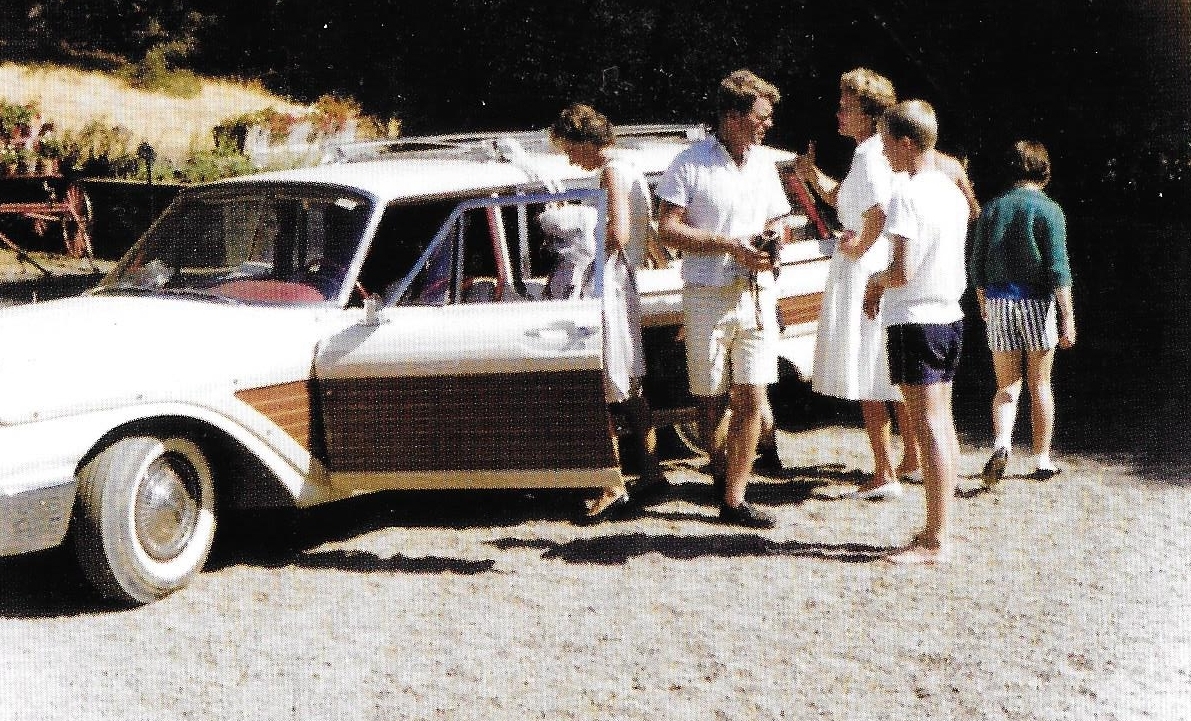
Mark Shaw asserted that he obtained the Bates family photograph from Troy Vaughn, a former deputy sheriff and forensics expert from South Carolina, implying that the photograph had been kept hidden, was a deep and dark secret for nearly six decades, that is until Shaw discovered it, certainly a false implication. Actually, Susan Bernard, the daughter of the famous photographer Bruno Bernard of Hollywood, published not only the above photograph, but nine other photographs snapped by the Bates family during the Kennedy’s visit to their ranch that August weekend. Susan’s famous father not only photographed Marilyn on numerous occasions, he was also the movie star’s close friend; and Susan included the Bates photographs in her 2011 photo journal, Marilyn: Intimate Exposures, which featured her father’s work with the movie star. Therefore, the photograph’s existence has been known for at least a decade, but frankly and actually, much longer than that. Still, those facts did not interest Shaw. He called his reader’s attention to the automobile with the driver’s side door open and the wood paneling beneath the window (Shaw 485). Was the paneling actually wood?—but then, I digress.
Shaw was just getting started; after the photograph of the Bates’ station wagon, he published the photograph on the left, displayed below. Shaw failed to publish the photograph on the right, which also occurred on Sunday morning, August the 5th. The photograph on the right would have amplified and clarified the scene occurring in the photograph on the left.

According to Shaw’s analysis of the tragic scene, a remarkable example of journalistic malpractice and disinformation, the photograph depicts two men, perhaps from the mortuary, wheeling Marilyn’s covered body not out of, for whatever reason, but into her home on the day she died. Shaw then called his reader’s attention to the station wagon pictured in the distance and stated that it appears to be a duplicate of the car RFK and his family were standing by at the Bates ranch. Shaw conceded, however, that the presence of the automobile might simply be coincidental. O really?! But he then speculated that somehow the car was driven from Gilroy to Los Angeles and then appeared at Marilyn’s death scene. He bemoaned the unfortunate reality that the individual who drove the car that eventful Saturday, requiring a time investment of at least ten hours round trip, by the way, will never be known.
What exactly is happening in the second photograph that Shaw published, the one on the left in the two photo panel above? It depicts Pierce Brothers Cemetery and Mortuary employees wheeling Marilyn into that facility after her body had been delivered by Don and Guy Hockett, not into her house at Fifth Helena Drive, clearly a complete misrepresentation by Shaw. Also, the photograph on the right side of the panel depicts Coroner employees removing Marilyn’s body from the cemetery mortuary for its transportation downtown Los Angeles for autopsy. Often, writers have erroneously asserted that the men in the snapshot are policemen.
Please return briefly to the first photograph of the Kennedy family preparing to leave the Bates ranch. You will note that the pictured station wagon had been equipped with a roof-mounted luggage rack. The distant station wagon in the left hand photograph above does not have a luggage rack. Also, since that photograph is black and white, we have no way of comparing the automobile’s colors; and too, please note the amount of open space, open land in the receding distance beyond the duplicate station wagon and also note the slender palm trees. Below is an aerial view of Marilyn’s cramped property with its kidney-shaped swimming pool, left side, combined with a photograph of Pierce Brothers Westwood Village Cemetery, right side.

Clearly, the photograph of the two men wheeling Marilyn’s body into the mortuary was not taken at Marilyn’s hacienda on Fifth Helena. It was taken at the Pierce Brother’s Westwood Village Cemetery and Mortuary, where Joe DiMaggio had Marilyn interred on August the 8th. Additionally, Marilyn’s hacienda did not have French doors, a fact confirmed by the floor plan of the hacienda as it actually existed in 1962, displayed below.
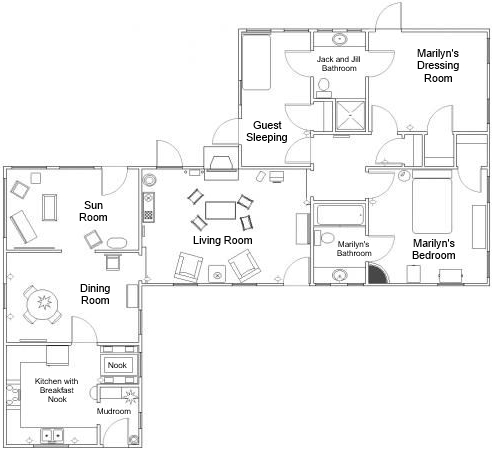
More Incorrect Depictions
Like most dutiful conspiracists, Shaw published the police photograph of Marilyn’s bedside table; and like his conspiracist compatriots, he published a cropped version, included below. Dutifully he also noted that a drinking glass was not on Marilyn’s bedside table and one could not be found, neither in her bedroom nor her adjoining bathroom.
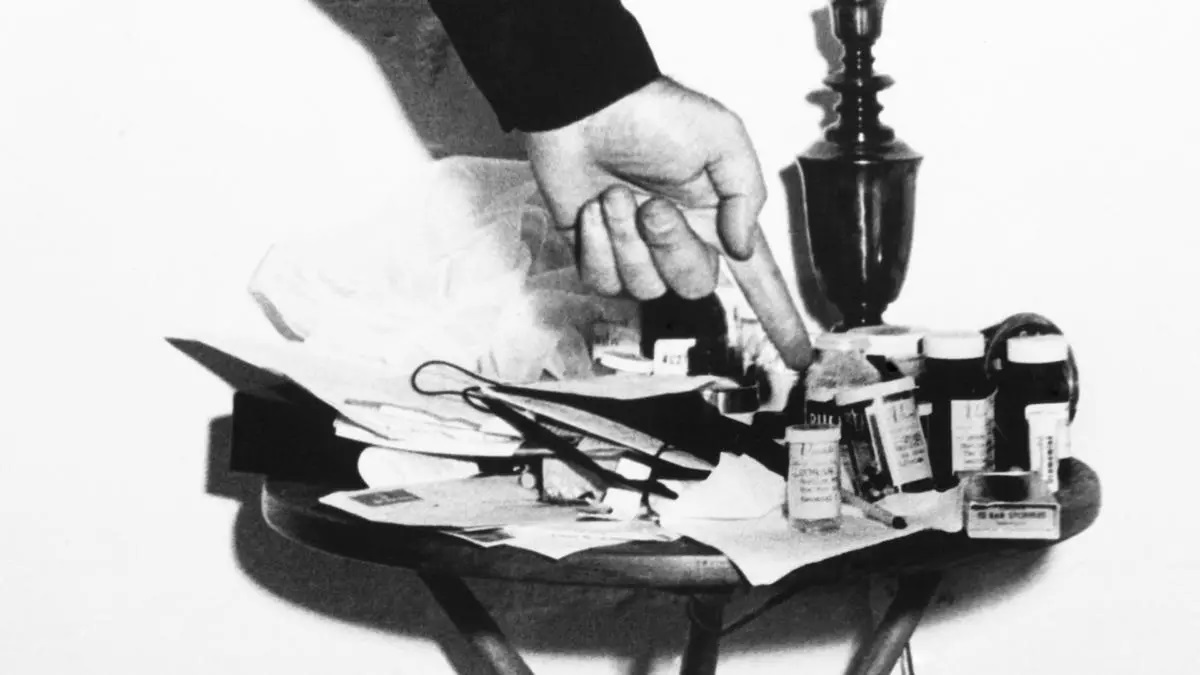
Displayed below is the actual, uncropped photograph taken that Sunday morning by police combined with an enlargement of the trash can area. Please note the drinking glass to the right of the trash can on the floor and to the left of Marilyn’s bed, a clearly visible drinking glass.
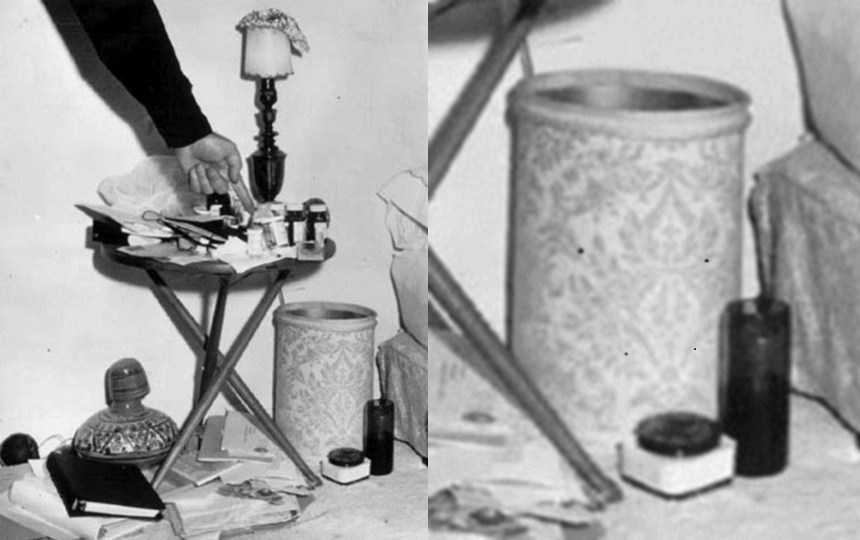
Following the photograph of the bedside table, Shaw published another police photograph of Marilyn’s bedroom, looking at her bedroom door, displayed below. While a policeman looked at the cluttered bedroom, beyond him was a woman with her back to the camera. Shaw labeled that woman as unidentified; but in fact, a comparison of other photographs taken that morning would have confirmed her identity if Shaw actually did not recognize her: Eunice Murray, Marilyn’s housekeeper.
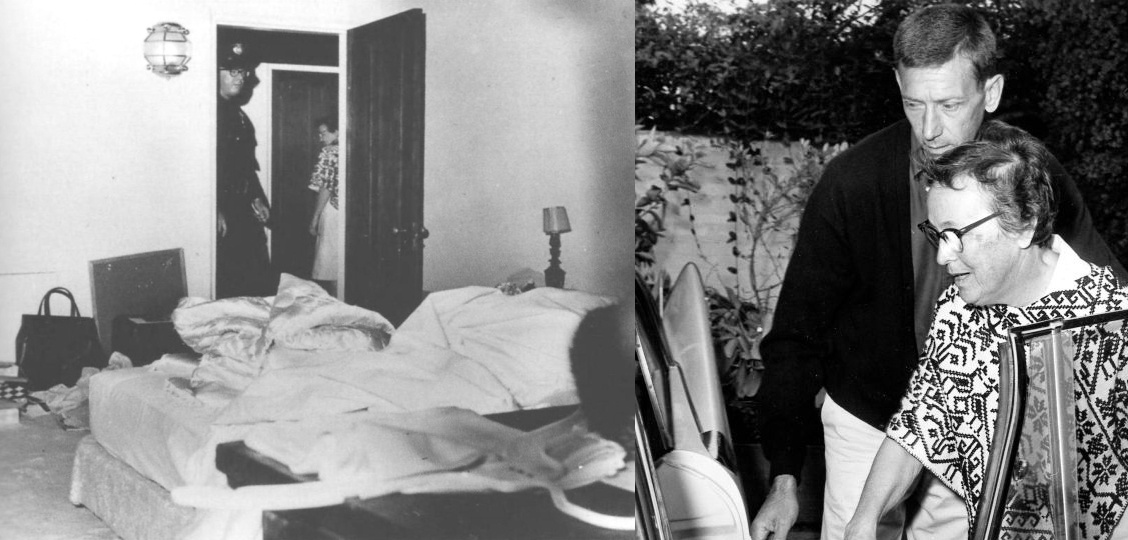
Regarding a related matter, Shaw included what he asserted was the bedroom wing layout of Marilyn’s hacienda; and he paraphrased Eunice Murray’s testimony about that tragic Sunday morning: while on the way to her bathroom, Shaw noted, she [Mrs. Murray] noticed light visible beneath Marilyn’s door, causing her to become suspicious that something could be wrong (Shaw 597). However, Shaw doubted that testimony, calling it inconsistent and apparently a lie. The layout of Marilyn’s home, he asserted, rendered her testimony unlikely or even impossible: Mrs. Murray had to leave her bedroom and walk into the hall in order to notice a light under Marilyn’s bedroom door (Shaw 597). Displayed below is the drawing that Shaw used to confirm his assertion.
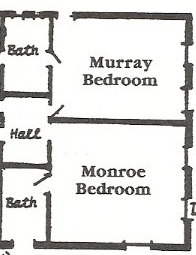
However, there is a major problem with that drawing: it is grossly inaccurate. Where are the clothes closets between the bedrooms, the linen closet and where is the corner fireplace in Marilyn’s bedroom? Plus the room denoted as Murray Bedroom was actually a bedroom Marilyn had reconfigured into her dressing room. Displayed below is the correct bedroom wing floor plan as it was in 1962.

On the night of August the 4th, Eunice Murray slept in the smaller bedroom where Marilyn had positioned a cot, identified on the floor plan as Guest Sleeping. Pat Newcomb had slept in the same bedroom on the same cot when she spent Friday night with Marilyn. It is apparent that Mrs. Murray could have noticed light emanating from Marilyn’s bedroom on her way to the Jack and Jill bathroom; and considering the arrangement of the bedroom’s doors, she could have stood at her bedroom door and easily observed Marilyn’s bedroom door. In the police photograph of Marilyn’s bedroom, looking across her disheveled bed at the opposing wall, clearly Mrs. Murray was preparing to enter the bedroom where she had slept, clearly visible from Marilyn’s bedroom door.
On page 515, Shaw published a photograph of Marilyn with her arm around the neck of a young fan, taken either preceding or following the premier of How to Marry a Millionaire on November the 4th in 1953. Shaw identified that young man as Joe DiMaggio, Jr. Odd. Where is Joe DiMaggio, Sr.?—an important consideration left unconsidered by Mark Shaw.
Born on October the 23rd in 1941, the junior DiMaggio was twelve years old when How to Marry a Millionaire premiered in 1953; and considering that his mother, Dorothy Arnold, took her ex-husband to court in an attempt to keep the youngster away from Marilyn—Dorothy cited Marilyn’s unsavory vulgar character and her potential negative influence—it is more than highly unlikely that Dorothy would have allowed her twelve-year-old son to attend a movie premiere with the disreputable movie star. Besides, the young fellow in the photograph published by Shaw appears to be at least fourteen years old and possibly even older.
The combined photographs below prove as much. To the left is the cropped version of Marilyn and her young fan as published by Shaw. To the right is a photograph of the junior Joe taken with the senior Joe at Ebbets Field on October the 9th in 1953, approximately thirty days before the premiere of How to Marry a Millionaire. The lucky young man who received that hug from Marilyn was not Joe DiMaggio, Jr.
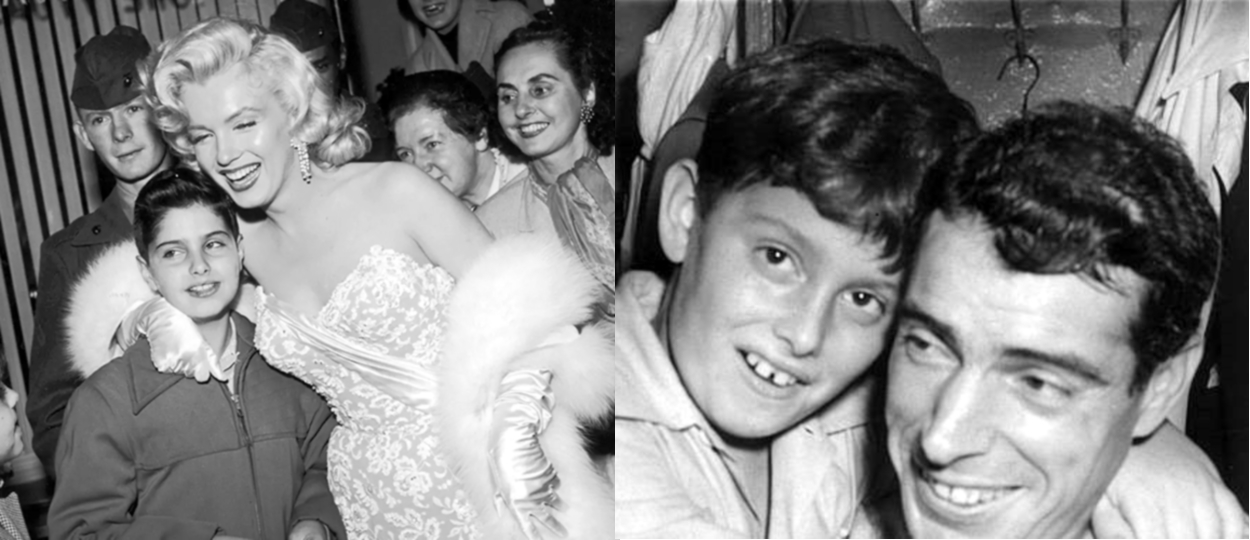
Finally, Shaw trotted out the famous thank-you note from Jean Kennedy Smith to Marilyn. During the Lawford’s 1962 February dinner party, attended by many persons, including Ethel Kennedy, Marilyn spoke to the ailing Kennedy clan patriarch via a telephone call instigated by Robert Kennedy: the old man had suffered a serious stroke on December the 19th in 1961, but he had yet to recover: he could barely speak. Robert must have felt that hearing Marilyn’s incredible voice would bolster, elevate the old man’s spirits. Sometime later, Marilyn sent a kind note to the senior Kennedy. In response to Marilyn’s kindness and her note, Jean Kennedy Smith wrote and sent Marilyn the aforementioned thank-you note. Both pages of the actual note follow.
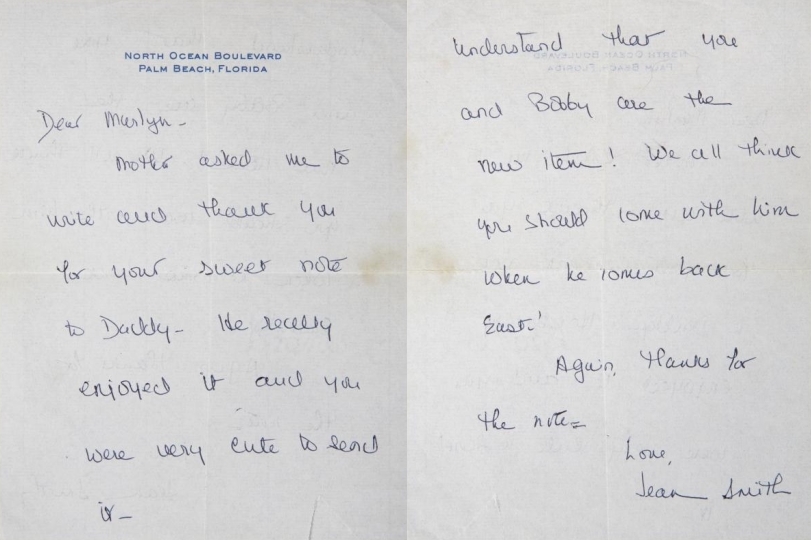
An innocent note, written and sent in response to a note that Marilyn sent to Joe Kennedy, Sr., it has always been of particular interest to conspiracists, including Shaw; but in his book, he published the note’s second page only, which begins with: understand that you and Bobby are the new item! Clearly Shaw did not publish the first page of the note for obvious and deceptive reasons. Like conspiracists before him, Shaw breathlessly pointed to the thank you note as evidence and proof that Marilyn and Robert Kennedy were involved in an affair; and the invitation extended by Jean Smith for Marilyn to join Bobby when he returned to the east has been used by the conspiracists as evidence that Robert Kennedy’s extramarital relationship with Marilyn had been accepted by the Kennedy clan, specifically the Kennedy women. Should we assume, then, that both Ethel Kennedy and Jacqueline Kennedy had also accepted Bobby’s extramarital relationship with Marilyn?
Since Shaw ignored the first page of the thank you note, he was able to write the following ridiculous assertion: Whatever Kennedy Smith knew―whether from the mouth of her brother or through perhaps Peter Lawford, married to Pat Kennedy―had triggered the letter (Shaw 572). As the first sentence of the thank-you note clearly stated, Rose Kennedy asked her daughter to write and thank Marilyn. That request triggered the letter, not something nefarious.
During the decades since the note was sent to Marilyn by Jean Smith, its context has been completely disregard-ed by the conspiracists, including Mark Shaw. Obviously, the comment about Marilyn and Bobby being the new item was meant as a tongue-in-cheek reference to Marilyn’s twist teaching efforts during the Lawford’s February dinner party and the uproarious scene caused by Robert Kennedy attempting to dance with Marilyn Monroe. Evidently, Ethel constantly teased the attorney general over that humorous scene, as frequently noted by John Seigenthaler, Robert Kennedy’s friend and assistant. Seigenthaler also attended that dinner party
That Jean Smith would invite Marilyn to visit Hyannisport seems only natural: who would not want Marilyn Monroe in their home for a visit? In point of fact, the lack of an invitation for Marilyn to visit would have appeared suspicious.
The conspiracist’s efforts to use that innocent note as proof of not only a romantic affair but the affair’s acceptance by the Kennedy clan and the Kennedy women is especially preposterous; and the conspiracist’s opinions should be viewed realistically, viewed for what those opinions have been: an effort to fabricate evidence where no evidence actually existed or actually exists, an effort of which Mark Shaw was also guilty.
The photographs employed by Mark Shaw, along with his commentary and evaluation of each, exposed and clarified his most important purpose; and his purpose was not to reveal the facts leading to the truth. It was to create an environs in which he could offer unfounded innuendo and speculation and engage in the most egregious form of evidence fabrication since Sgt Jack Clemmons and Frank Capell, Robert Slatzer and Jeanne Carmen and others of their ilk. For an author to place himself in such a dubitable crowd is―well, mystifying.
